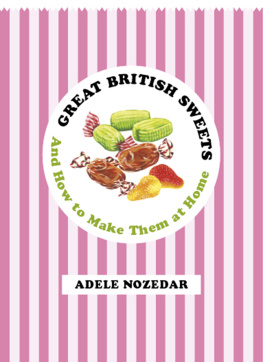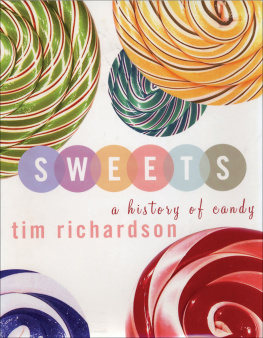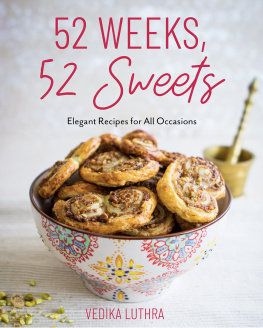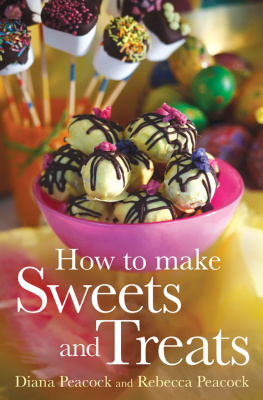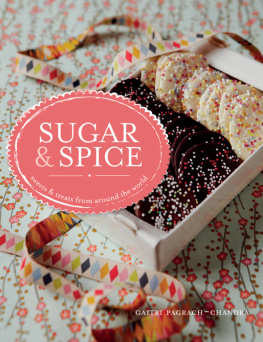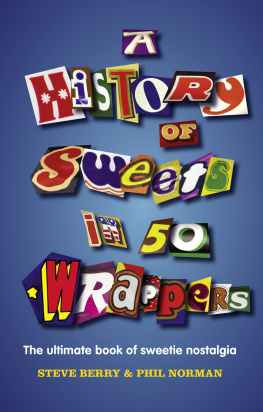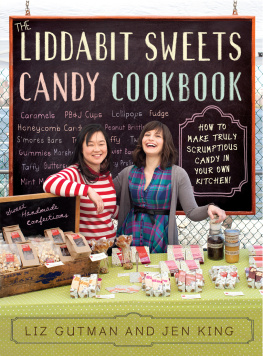Contents
About the Book
Great British Sweets is a gloriously indulgent celebration of our Great British love affair with sweet-making and good old-fashioned confectionery.
From pear drops to humbugs, honeycomb confections to liquorice, coconut ice to sugar mice, Nozedar gives us the rich history of these classic sweets along with over 50 easy-to-follow recipes for how to make them at home.
About the Author
Adele Nozedar is an author and photographer. Previously, she was in a cult Indie band, then ran her own indie record label and became A&R Director/General Manager of a major record company.
Her wide-ranging passions are reflected in her books, which include The Hedgerow Handbook (2012), The Signs and Symbols Sourcebook (2011), The Secret Language of Birds (2006), and The Element Encyclopedia of Native Americans (2013).
Also by Adele Nozedar
The Hedgerow Handbook
This ebook is copyright material and must not be copied, reproduced, transferred, distributed, leased, licensed or publicly performed or used in any way except as specifically permitted in writing by the publishers, as allowed under the terms and conditions under which it was purchased or as strictly permitted by applicable copyright law. Any unauthorized distribution or use of this text may be a direct infringement of the authors and publishers rights and those responsible may be liable in law accordingly.
Version 1.0
Epub ISBN 9781448161218
www.randomhouse.co.uk
Published by Square Peg 2014
2 4 6 8 10 9 7 5 3 1
Copyright Adele Nozedar 2014
Illustrations Graham Evernden 2014
Designed by Friederike Huber
Adele Nozedar has asserted her right under the Copyright, Designs and Patents Act 1988 to be identified as the author of this work
First published in Great Britain in 2014 by Square Peg
Random House,
20 Vauxhall Bridge Road,
London SW1V 2SA
www.vintage-books.co.uk
Addresses for companies within The Random House Group Limited can be found at: www.randomhouse.co.uk/offices.htm
The Random House Group Limited Reg. No. 954009
A CIP catalogue record for this book is available from the British Library
ISBN 9780224095747
This book is for all of you who are ingenious, enterprising, and eccentric, whether you like sweets or not.
Included in this number are the inestimable Liam, Saoirse and Colm, who all like sweets very much indeed.
Also embracing these qualities are Eve, Milo, Miranda, Mia, Saskia and Willa. Ditto.
And my good friend and travelling companion, Lisa, who doesnt eat sweets at all.
P.S. Tony Hamnet sorry we missed your party!
INTRODUCTION
This Sugared Isle
From the North to the South and the East to the West, we British are never very far from small, sugary objects, generally sparkling with colour, often a miniature work of art, which are deeply loved yet often overlooked. Yes, Im talking about our Great British Sweets!
Britain does sweets like no other nation on earth. But why? Historically we have had easy access to sugar. During the eighteenth and nineteenth centuries Britain became one of the largest importers of sugar from the West Indies and the Americas and our consumption of the sweet stuff increased to match its availability. But its not just about the sugar.
Id argue that the very nature of what it is to be British has a large part possibly the most important part to play in our great talent for inventing sweets. All the imagination, ingenuity, eccentricity and most of all the sense of humour that are part and parcel of our psyche are essential factors in explaining why Britain leads the way in sweet-making. After all, many of our traditional sweets are made of very few ingredients in some cases, little more than sugar and flavouring and yet they are so much more than the sum of their parts; ingenious little pocket-money treats that we think of with such great affection. And think of the names of those sweets: gobstoppers, humbugs, claggum, Yellow Man, nutty nubs, Curly Wurly, jelly babies and flumps Who else but us Brits could have invented such quirky and unfathomable names for a foodstuff?
The British love affair with sweets runs deep. In a fashion that can only be considered akin to Marcel Proust and his madeleine moment, sucking or biting into a childhood favourite can give rise to a fevered rush of nostalgia, throwing some of us back to endless summers, chopper bikes, space hoppers, grazed knees, first sticky kisses and the joy of spending our own pocket money. Sweets are an important part of our culture, our history, and our pride in where we come from and I wanted to find out more about them and why they are so revered.
I took a map and stuck a small marker on every city, town or village that has a sweet either associated with it or named after it. Before long, much of the map was hidden under a thick sprinkling of bright pink tags. And I decided, with my friend Lisa, to hunt down the inventors and makers of these amazing sweets in order to compile a compendium of some of our greatest British sweets. The subject of confectionery in general is vast, and so it was good to define some parameters in order to be able to narrow the list and assess what would make the cut for this book.
First, the sweet had to be invented in Britain. Secondly, I looked for the sweets that had odd and unexpected stories attached (a good example of this is the humble aniseed ball who would have considered that it would be tested as a detonation device for a limpet mine?) Thirdly, the sweets had to have withstood the test of time. I realised that the sweets invented more recently by focus groups or marketing experts just didnt hit the mark in quite the same way. The striking result of all this is that there are quite a lot of toffees in the book; all are slightly different, though, according to regional variations such as the availability of certain ingredients the rich milk in Devon and Cornwall, or oats in Scotland.
Along the way I made some fascinating discoveries. I was surprised to notice that the sweet industry in the UK is incredibly healthy. At a time when we are constantly being told the manufacturing industry is dead, I discovered that the opposite is true, at least as far as confectionery is concerned. And not only that, but the majority of sweet-makers I encountered are actually expanding, Sweet shops, too, are on the rise.
The other exciting thing I learned was that lots of our sweet companies have been going for years and years hundreds of years in some cases. One sweet maker, Grays of Dudley, is still going strong after five generations, with one member of the founding family describing working for the company as like being on board a ship, everyone working together and pitching in to do whatever needs to be done. Sweet makers are also passionate people. I found an Indian confectioner in Scotland, Sunny Pahuja, who saved 150 jobs by investing his life savings in a sweet company that he was passionate about, and I found a young couple in Bridgend, Steve and Freya, who took on the mighty Kraft empire to rescue their famous family name and won. I discovered that the Quaker families who founded some of our most illustrious confectionery companies were ahead of their time in treating their staff fairly and in paying women the same wages as men. I found another long-established family company who are currently re-jigging their operation to encompass the sixth generation of owners, two little boys aged just seven and ten at the time of writing, who are keen to get going in the business. What a legacy those boys will have!

